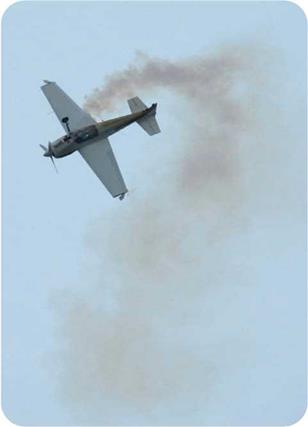Stall
|
A |
stall is a sudden loss of lift that can be experienced by an aircraft in some circumstances. Pilots are trained to understand why a stall can happen, how to recognize the early signs of a stall, and how to recover from a stall if one occurs.
How It Happens
When a fixed-wing aircraft slows down, the speed of the air flowing over its wings decreases, and the wings produce
Г
|
|
Angle of attack 25
Separated (turbulent) flow
less lift. While flying slowly, the pilot can increase lift by raising the plane’s nose. As the wings tip up, they produce more lift and more drag. The angle of tilt of a wing is called its angle of attack. If the pilot keeps raising a plane’s nose, the angle of attack becomes so great that the air flowing smoothly over the wings suddenly breaks away from them and changes into turbulent, swirling flow. This angle is called the critical angle of attack. When the smooth airflow over the wing breaks down, lift is suddenly lost, and the aircraft drops downward. If one wing stalls before the other, the plane may roll into a spin.
Stall also affects helicopters. When a helicopter’s main rotor spins, the blades moving in the same direction as the aircraft are called the advancing blades, and the blades traveling in the opposite direction are called the retreating blades. Air flows over the advancing blades faster than it flows over the retreating blades, so the advancing blades experience greater lift. If the airflow over the retreating blades is slow enough, they can stall. The helicopter experiences a sudden loss of lift called a retreating blade stall, but only on one side. The advancing blades still produce lift, so the helicopter rolls over to one side.
Recovering from a Stall
A pilot can recover from a stall in two ways. Pushing the control stick forward lowers a plane’s nose, so that it dives and picks up speed. Air flows smoothly over the wing again, and lift returns.
|
ENGINE STALL |
When a piston engine stops unexpectedly, it is said to have stalled, but this is completely different from the aerodynamic stall that happens to wings. If a piston engine in an aircraft stalls, the plane does not drop like a stone. It becomes a glider. As it glides down, the pilot can look for a suitable landing spot while trying to restart the engine.
Jet engines can suffer from a problem called compressor stall. The spinning compressor blades inside the engine work like small wings.
Just like wings, they can stall. If the smooth airflow entering a jet engine is disturbed, the compressor blades may stall. A common cause of compressor stall is a bird strike, when a bird is sucked into an engine. When a compressor stall happens, the engine makes a loud bang and loses thrust, and the aircraft turns toward the affected side.
_____________________________________________ )
The pilot then can raise the nose and fly straight and level again. The other way to recover from a stall is to increase engine power. When a stalled aircraft accelerates, it lowers its nose, and smooth airflow over its wings is restored. The two methods can be used together. A stall-as well as the recovery
|
О Stalling will often send an airplane into a spin. |
from it-always causes some loss of altitude, so a stall near the ground can be particularly dangerous.
Large aircraft are equipped with systems that sense when a stall is about to happen. They warn the pilot by shaking the control stick and sounding a warning. If the pilot does nothing, the system may push the control stick forward to automatically lower the plane’s nose.












